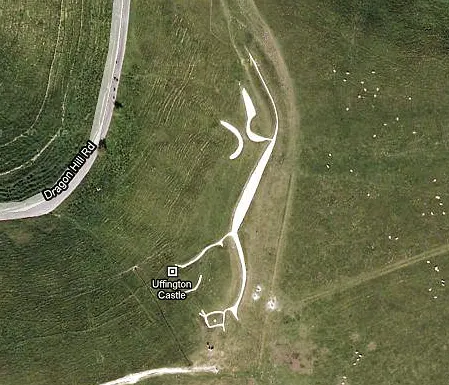Let’s play a game.
I’m thinking of a thing. It’s white and big and horse related, and you can find it by putting the following code into Google: 51.57753, -1.56668. Make sure you click on Satellite when you get there.
See it yet? Zoom in.
Anything yet? No? Keep zooming!
Turn your head to the right, and… Hey! That looks like…
A horse! The Uffington White Horse, to be precise, one of the most famous chalk figures on the hills of England. We’ll call him Uffy.
Some experts believe Uffy was born as far back as 3,000 years ago, between 1400 and 600 B.C., in Oxfordshire, where he’s lived his whole life. While Uffy, who measures 360 feet long and 130 feet tall, has a lot of friends in England, especially in the county of Wiltshire, he’s the oldest of the gang. He’s also thought to be the oldest hill figure in Britain.
Until about the late 18th century, Uffy’s chalk base was ritually scoured every seven years under the watchful eye of the local lord, who also got to fund the massive community event. Free drinks for all! The event was first recorded by Thomas Baskerville in 1677, but the party had to have been going on for centuries, otherwise Uffy would have disappeared beneath the ground cover years ago.
ADVERTISEMENT
The festival would often last for days and included fun and games, cheese rolling, wrestling and other pastimes. The majority of the celebration took place in the Uffington Castle, an Iron Age hill fort, which Uffy seems to be galloping toward.
Unfortunately, Uffy became somewhat neglected after World War I. During World War II, Uffy was deliberately covered in order to prevent German bombers from using it as a navigation aid. The end of the war, however, brought Uffy new life.
There’s some debate whether Uffy is actually a horse or not (some think he’s having identity issues and is really a dragon), but he has been regarded as a horse since medieval times. A document from the Abbey of Abingdon from between 1072 and 1084 refers to “the place commonly known as the White Horse Hill” and, well, the rest is history!
Experts have also widely debated why Uffy was made in the first place. Some think that he was the emblem of a local tribe and was cut as a totem or badge marking their land or was significant to their religion, while others think the figure represents a horse goddess, generally believed to be one form of Epona, who was worshipped throughout the Celtic world.
Another theory is that worshippers of the sun god Belinos (or Belenus), who was associated with horses, might have had the ingenious idea. They were a rather bright bunch, after all, and Mr. B was often depicted on horseback or driving horse drawn chariots.
Others, however, believe Uffy might be much younger.
King Alfred the Great, who reigned from 871-899, was the only English monarch to be known as “the Great.” He achieved this honor by defeating the Danes in the Battle of Ethandun and continuing to thwart their attacks until his death in 899. Some believe that he commissioned Uffy after his victories over the Danes.
Still another theory pins Uffy as St. George’s steed or as the dragon that he killed. St. George is England’s patron saint, and his most famous deed—slaying the dragon—supposedly took place on Dragon Hill, which is situated in the valley below Uffy.
ADVERTISEMENT
Regardless of the who and why behind Uffy, he is visited by more than 200,000 people each year, who come to climb the slopes to take in a little bit of England’s history. Uffy certainly doesn’t mind the attention; he’s one of the cleanest white horses I’ve ever seen!
Here’s a song that was composed around the tradition of cleaning Uffy.
The Old White Horse wants setting to rights
And the Squire has promised good cheer;
So we’ll give him a scrape to keep him in shape,
And he’ll last for many a year.
He was made a long, long time ago
With a great deal of labour and pains,
By King Alfred the Great, when he spoiled their conceit,
And caddled those worsbirds the Danes.
The Blowing-Stone, in days gone by,
Was King Alfred’s bugle horn,
And the Thorning-Tree you may plainly see,
Which is called King Alfred’s Thorn.
They’ll be backsword play, and climbing the pole,
And a race for pig and cheese;
And we think as he’s a dumble soul
Who don’t care for such sports as these.
One of web writer Coree Reuter’s favorite parts of working at The Chronicle of the Horse is adventuring up into the attic. While it’s occasionally a journey that requires a head lamp, GPS unit and dust mask, nearly 75 years of the equine industry is documented in the old issues and photographs that live above the offices, and Coree is determined to unearth the great stories of the past. Inspired by the saying: “History was written on the back of a horse,” she hopes to demystify the legends, find new ones and honor the horses who have changed the scope of everyday life with this blog.
Curious about anything in particular? Have a question or an interesting topic? Please e-mail Coree, she’d love to hear from you!















